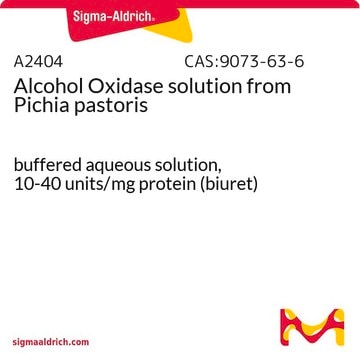추천 제품
애플리케이션
D-fructose dehydrogenase is used as a biosensor to detect the presence of D-fructose.
Fructose dehydrogenase (FDH) is used in a number of basic research projects to examine the electrochemical properties of enzyme-catalyzed electrode reactions called bioelectrocatalysis. D-fructose dehydrogenase has been used in a study that contributed towards a convenient method for measuring rare sugars, monosaccharides, for applications in the bio-industry. A direct electron transfer reaction of d-fructose dehydrogenase adsorbed on a porous carbon electrode surface has been used to describe a batch-type coulometric d-fructose biosensor.
생화학적/생리학적 작용
D-fructose dehydrogenase catalyzes the oxidation of D-fructose to 5-keto-D-fructose.
Fructose dehydrogenase (FDH) is a heterotrimeric membrane-bound enzyme commonly seen in various Gluconobacter sp. especially in Gluconobacter japonicus (Gluconobacter industrius). It has a molecular mass of ca. 140 kDa, consisting of subunits I (67kDa), II (51 kDa), and III (20 kDa) and catalyzes the oxidation of D-fructose to produce 5-keto-D-fructose. The enzyme is a flavoprotein-cytochrome c complex with subunits I and II covalently bound to flavin adenine dinucleotide (FAD) and heme C as prosthetic groups, respectively.
단위 정의
One unit will convert 1.0 μmole D-fructose to 5-ketofructose per min at pH 4.5 at 37 °C.
물리적 형태
Lyophilized powder containing citrate-phosphate buffer salts, TRITON® X-100, and stabilizer
Storage Class Code
11 - Combustible Solids
WGK
WGK 3
Flash Point (°F)
Not applicable
Flash Point (°C)
Not applicable
개인 보호 장비
Eyeshields, Gloves, type N95 (US)
시험 성적서(COA)
제품의 로트/배치 번호를 입력하여 시험 성적서(COA)을 검색하십시오. 로트 및 배치 번호는 제품 라벨에 있는 ‘로트’ 또는 ‘배치’라는 용어 뒤에서 찾을 수 있습니다.
Seiya Tsujimura et al.
Analytical chemistry, 81(22), 9383-9387 (2009-11-17)
This paper describes a batch-type coulometric d-fructose biosensor based on direct electron transfer reaction of d-fructose dehydrogenase (FDH) adsorbed on a porous carbon electrode surface. The adsorbed-FDH electrodes catalyzed the electrochemical two-electron oxidation of d-fructose to 5-keto-d-fructose without a mediator.
Ana Dominguez et al.
Revista iberoamericana de micologia, 23(3), 189-191 (2007-01-02)
Several microorganisms are reported to have transfructosylation activity due to fructosyltransferase and/or fructofuranosidase activities. However, the search for other fungi with higher transfructosylation activity remains a challenge. So, a presumptive and indirect colorimetric plate assay for the evaluation of transfructosylation
Takeo Miyake et al.
Journal of the American Chemical Society, 133(13), 5129-5134 (2011-03-12)
Nanostructured carbons have been widely used for fabricating enzyme-modified electrodes due to their large specific surface area. However, because they are random aggregates of particular or tubular nanocarbons, the postmodification of enzymes to their intrananospace is generally hard to control.
Xuee Wu et al.
Biosensors & bioelectronics, 25(2), 326-331 (2009-08-14)
The construction and characterization of a one-compartment fructose/air biological fuel cell (BFC) based on direct electron transfer is reported. The BFC employs bilirubin oxidase and d-fructose dehydrogenase adsorbed on a cellulose-multiwall carbon nanotube (MWCNT) matrix, reconstituted with an ionic liquid
Amperometric flow injection determination of fructose with an immobilized fructose 5-dehydrogenase reactor.
K Matsumoto et al.
Analytical chemistry, 58(13), 2732-2734 (1986-11-01)
자사의 과학자팀은 생명 과학, 재료 과학, 화학 합성, 크로마토그래피, 분석 및 기타 많은 영역을 포함한 모든 과학 분야에 경험이 있습니다..
고객지원팀으로 연락바랍니다.





